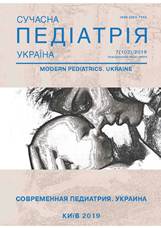Infectious mononucleosis: the multiplicity of manifestations. a clinical case of a severe course of infectious mononucleosis in an infant
Keywords:
infectious mononucleosis, infants, diagnosing, polyserosisAbstract
Epstein–Barr virus infected more than 95% of the world's population. Difficulties in diagnosing this disease are caused by polymorphism of clinical manifestations.Aim: on a clinical case, show the versatility of the manifestations of infectious mononucleosis in children.
Materials and methods. The clinical manifestations of an atypical severe course of infectious mononucleosis in a little child at the stage of hospital`s treatment are analyzed.
Results and conclusions. In a child with a nephropathy in anamnesis, infectious mononucleosis proceeded in a severe form with significant edematous syndrome and the absence of typical symptoms in the form of tonsillitis, a systemic inflammatory reaction, and lymphadenopathy. This made diagnosis difficult and required additional laboratory tests and the appointment of glucocorticosteroids in therapy.
The presented clinical case demonstrates the polymorphism of the clinical manifestations of the disease and the complexity of the diagnosis of severe cases of infectious mononucleosis due to the occurrence of atypical syndromes — polyserositis and edematous syndrome with the leveling of typical manifestations of the disease.
The research was carried out in accordance with the principles of the Helsinki Declaration. The study protocol was approved by the Local Ethics Committee of an institution. The informed consent of the patient was obtained for conducting the studies.
References
Volokha AP. (2015). Epstein—Barr viral infection in children. Sovremennaya pediatriya. 4(68): 103–110. https://doi.org/10.15574/SP.2015.68.103
Golubovskaya OA (red.), Andrejchin MA, Shkurba AV. (2014). Infectious diseases. Kiev: 783.
Ivanova LA, Garas MN, Andrijchuk TR. (2016). Clinic-sonographic indicators as diagnostic criteria for infectious mononucleosis in children. Aktualnaya infektologiya. 2(11): 160-165. https://doi.org/10.22141/2312-413x.2.11.2016.77664
Kruglikov VT, Bagdasarova IV, Kruglikova IV ta in. (2015). Herpes virus infection and glomerulonephritis in children. Ukrayinskij zhurnal nefrologiyi ta dializu. 2(46): 61–67. https://doi.org/10.31450/ukrjnd.2(46).2015.10
Kharchenko YuP, Zaretskaia AV, Hudz VA, Slobodnichenko LM, Tselukh VA. (2017). The influence of etiological polymorphism on clinical manifestations and treatment of infectious mononucleosis in children. Sovremennaya pediatriya. 3(83): 68-74 https://doi.org/10.15574/SP.2017.83.68
Harchenko YuP, Zareckaya AV, Yurchenko IV i dr. (2018). Features of the clinical manifestations of infectious mononucleosis mixed etiology in a child 3 years of age. Aktualna infektologiya. 6;1: 48-51. https://doi.org/10.22141/2312-413x.6.1.2018.125637
Simre K, Uibo O, Peet A. et al. (2019, Sep). Early life exposure to common virus infections did not differ between coeliac disease patients and controls. Acta Paediatr. 108(9):1709-171. https://doi.org/10.1111/apa.14791.
Downloads
Issue
Section
License
The policy of the Journal “MODERN PEDIATRICS. UKRAINE” is compatible with the vast majority of funders' of open access and self-archiving policies. The journal provides immediate open access route being convinced that everyone – not only scientists - can benefit from research results, and publishes articles exclusively under open access distribution, with a Creative Commons Attribution-Noncommercial 4.0 international license (СС BY-NC).
Authors transfer the copyright to the Journal “MODERN PEDIATRICS. UKRAINE” when the manuscript is accepted for publication. Authors declare that this manuscript has not been published nor is under simultaneous consideration for publication elsewhere. After publication, the articles become freely available on-line to the public.
Readers have the right to use, distribute, and reproduce articles in any medium, provided the articles and the journal are properly cited.
The use of published materials for commercial purposes is strongly prohibited.

